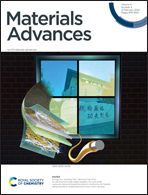Shape deformable hydrogels prepared by altering surface areas with scratching and photolithography patterning methods
Abstract
Shape deformable hydrogels have wide potential applications in soft robotics, artificial muscles, manipulators and flexible devices. The development of simple, facile and efficient methods for preparing shape deformable hydrogels is of significant importance for their practical applications. In this work, we proposed a novel strategy to transform isotropic hydrogels into shape deformable hydrogels by altering the surface areas and hence the swelling behaviours of hydrogels. Simple scratching and photolithography patterning methods are employed to introduce grooves or projections on the surface of hydrogels. By controlling the density and direction of scratches, or the width, density, height and direction of the stripes, the degree and direction of the bending and twisting of the hydrogel can be adjusted. Taking the advantages of the photolithography method, more precise and complex patterns can be introduced onto hydrogel samples with different shapes; therefore, more complex shape deformations from 2D to 3D can be achieved. The strategy of changing surface area to endow isotropic hydrogels with shape deformation behaviour can be applied to a wide variety of hydrogels and many methods can be employed; therefore, it is of great significance for many practical applications.



 Please wait while we load your content...
Please wait while we load your content...